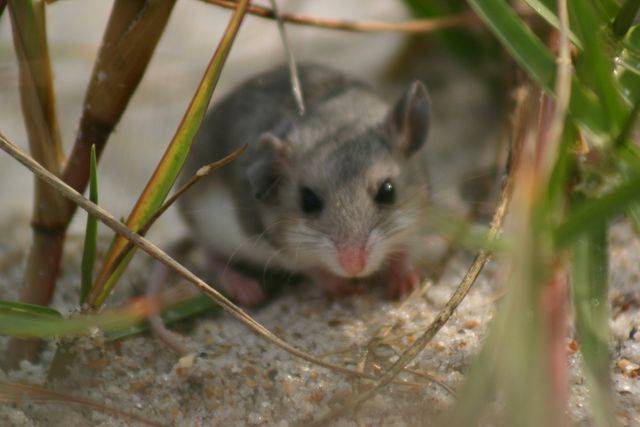Southeastern Beach Mouse Questions
From Indian River Lagoon Project
Frequently Asked Questions (FAQs) about Florida's Southeastern beach mouse (Peromyscus_polionotus_niveiventris) .
Southeastern Beach Mouse Questions
What is a beach mouse?
There are 16 subspecies of the old-field mouse (Peromyscus polionotus). Eight of these are considered to be beach mice. Four of these subspecies live on the Florida panhandle’s Gulf coast: the St. Andrews beach mouse, Choctawhatchee beach mouse, Santa Rosa beach mouse and the Perdido Key beach mouse. The aptly named Alabama beach mouse lives in Alabama. Two of the subspecies reside on Florida’s east coast: the Anastasia Island beach mouse and Southeastern beach mouse. The Pallid beach mouse lived on the east coast, but is believed to be extinct.
Which subspecies of beach mouse is found in the Indian River Lagoon watershed?
The southeastern beach mouse lives on three federal properties within the North Indian River Lagoon: Cape Canaveral Air Force Station (CCAFS), Merritt Island National Wildlife Refuge (MINWR) and Canaveral National Seashore (CNS). Historically, the southeastern beach mouse range was approximately 360 km from Ponce Inlet (Volusia County) to Hollywood Beach (Broward County). Its current range has been reduced by more than 79 percent and the core population resides on MINWR, CNS, KSC, and CCAFS; and a couple of relict populations reside to the north at Smyrna Dunes Park (Volusia County), to the south at Sebastian Inlet State Park (Brevard and Indian River County) and Pelican Island National Wildlife Refuge (Indian River County).
Where do southeastern beach mice live?
These beach mice live in coastal dunes, strand and scrub habitats in Florida and Alabama. Unlike many other small mammals, beach mice live underground in burrows that they dig themselves. Like gopher tortoises they have several burrows within their home range.
What do southeastern beach mice eat?
These beach mice are omnivores, meaning they will eat both plants and animals, although they primarily eat seeds and fruits of dune plants and invertebrates (insects). Some examples of food sources are sea oats, dune sunflower, ground cherry, and Smilax or greenbriar.
How big are southeastern beach mice?
Adults average 13 grams with pregnant females exceeding 20 grams. Juveniles are all gray in color on their dorsal side and white on their chest and bellies and weigh an average of 8 grams.
How do you monitor beach mice populations?
As a requirement of the Endangered Species Act, beach mice populations are continually monitored to collect demographic data (age, sex, reproduction, weight, survival, etc.,) track their movements, and determine if an area is occupied. Using a mark-recapture technique, the mice are trapped and their right ears are tagged to identify each mouse and keep track of their movements. This information allows us to estimate their survival.
Are beach mice considered threatened or endangered?
All of the subspecies of beach mice, with the exception of the Santa Rosa beach mouse, are listed by both the state and federal government as either threatened or endangered. The biggest threats to beach mice’s survival is loss of habitat due to human development and tropical storms and hurricanes. Additional threats are habitat degradation and fragmentation and predation from feral and domesticated cats.
Why are beach mice important?
Beach mice provide important ecological roles promoting the health of our coastal dunes and beaches. Beach mice dig and utilize several burrows within their home range. These burrows aerate the dune substrate and encourage deep rooting of dune plants. Beach mice eat a variety of coastal plants, including seeds and flowers, which helps disperse these seeds throughout the coastal dune system promoting new growth that helps to stabilize the dunes making them more stable during storms and protecting the coast. Another benefit is that the beach mice eat insects that damage coastal plants.
What can you do to help?
* Stay off the dunes! Always use beach crossovers and boardwalks instead of walking through the dunes. * Dispose of garbage properly to help reduce predators and prevent entanglements of wildlife. * Keep all pets on a leash and cats indoors. Do not feed stray cats as this can attract them to beach mice habitats. * Leave dune plants as you found them. * Keep outdoor lighting to a minimum. Beach mice are nocturnal. * Don't use rodenticides or pesticides in coastal dune habitats. * Plant native coastal plants to help provide stability to the dune system and provide natural food sources.

